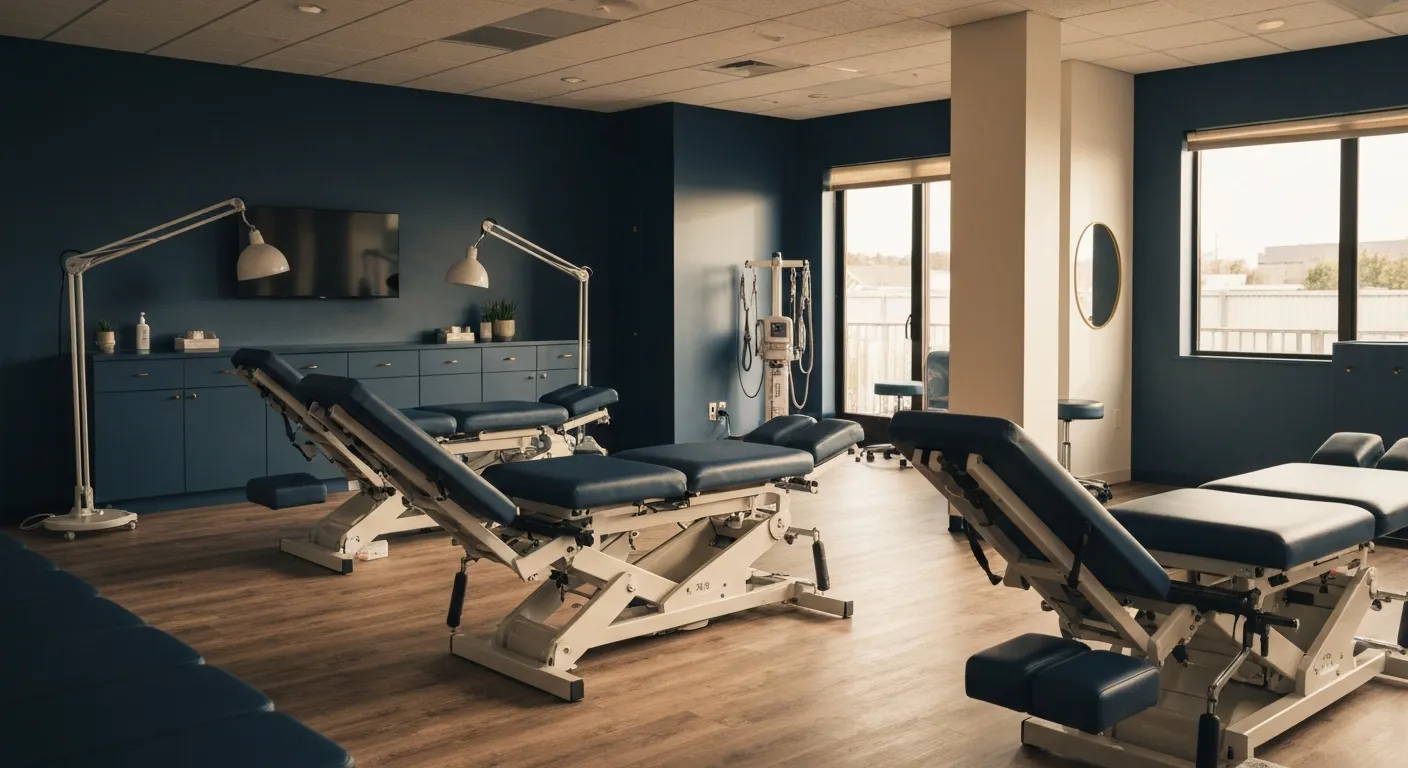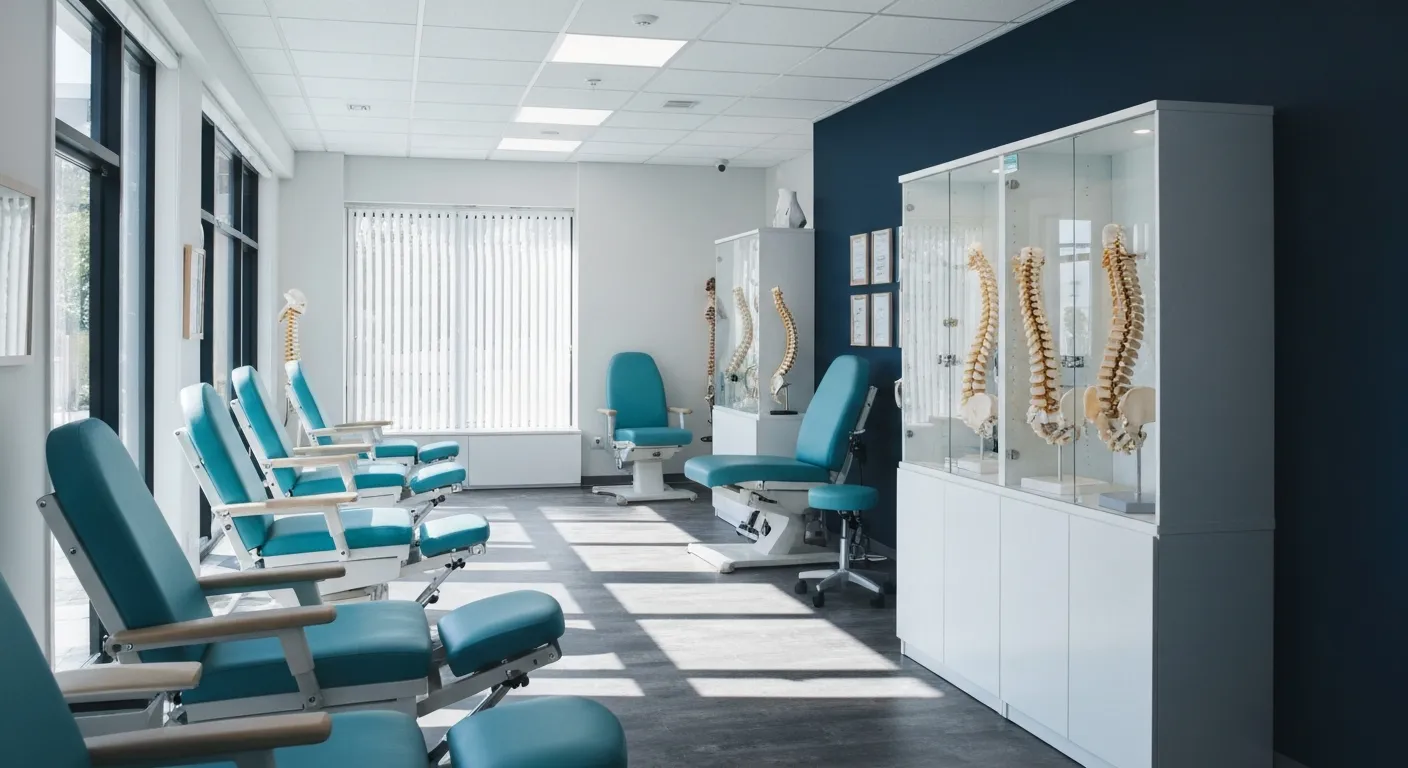Step-by-Step Guide to Your First Visit with a Chiropractor
October 20, 2025
7 min

Introduction to Chiropractic Care for First-Timers
If you're considering chiropractic care for the first time, knowing what to expect can ease any apprehensions and help you make the most of your visit. Chiropractors specialize in diagnosing and treating neuromusculoskeletal issues, focusing on the spine, joints, muscles, and related tissues. This guide walks you through the typical process of a first chiropractic appointment, from preparation to follow-up care, providing practical insights drawn from expert sources to ensure a confident and informed experience.
Before the Appointment: Preparation and What to Bring

How should I prepare for my first chiropractic visit?
Preparation for your first chiropractic appointment is straightforward yet important to ensure a smooth experience. Start by gathering all relevant medical records and insurance information, as these help your chiropractor understand your health background and facilitate billing processes. Be ready to clearly describe your symptoms, their onset, intensity, and any factors that affect them. Arriving about 15 minutes early allows time to complete necessary paperwork without feeling rushed. For detailed preparation tips for first chiropractic appointment, visit this resource.
What documents and information should I bring?
- Medical records related to your musculoskeletal health
- Current insurance card and identification
- A list of medications and supplements you take
- Notes on your symptoms, including pain locations and timing
- Previous imaging results, like X-rays or MRIs if available
What is appropriate attire for the visit?
Wearing loose, comfortable clothing is highly recommended. This type of attire allows easy access for chiropractic physical exams and any potential adjustments without restriction. Sportswear, yoga pants, or loose pants paired with a t-shirt usually work well.
Are there any diet or hydration recommendations before the appointment?
Eating a small meal or snack that is high in protein before your visit helps avoid low blood pressure during treatment. Drinking plenty of water keeps you hydrated and may improve your overall response to care. Mild physical activity such as walking or light stretching can also enhance the effectiveness of your appointment. For more on dietary and hydration tips before chiropractic care, see this guide.
By preparing these aspects ahead of your visit, you contribute to a more thorough, comfortable, and efficient chiropractic assessment and treatment process.
Initial Consultation: What Happens During Your First Visit

What can I expect during the first chiropractic consultation?
Your first chiropractic visit involves several important steps to understand your health and tailor treatment accordingly. Initially, the chiropractor will take a detailed medical history, discussing your current health status, past illnesses, symptoms such as pain or discomfort, and any lifestyle factors that might contribute (First chiropractic consultation).
Medical history intake and understanding symptoms
You will be asked about the onset, location, nature, and intensity of symptoms. This helps the chiropractor identify the root causes and any influencing factors. Openly sharing information about previous injuries, family medical history, and daily habits improves the assessment accuracy (Medical history in chiropractic assessment).
Physical examinations performed
The chiropractor will conduct a thorough physical exam that may include:
- Assessment of muscle strength, tone, and neurological function
- Reflex testing to check nerve integrity
- Orthopedic and neurological tests tailored to your symptoms (Chiropractic physical exam
Posture and range of motion assessments
A key part of the exam focuses on posture evaluation and range of motion tests. The chiropractor will observe your spinal alignment and measure how far you can move your joints in various directions, looking for asymmetries or restrictions that could signal joint dysfunction (Posture analysis and movement tests, Spinal alignment treatment.
Use of diagnostic imaging like X-rays
If needed, based on initial findings or specific concerns such as recent trauma or suspected spinal deformities, diagnostic imaging like X-rays may be ordered. These images help visualize structural issues but are only used when medically necessary to minimize exposure to radiation (Use of X-rays in chiropractic care, X-rays and MRI in chiropractic care).
This comprehensive initial consultation, usually lasting 45 minutes or more, culminates in a diagnosis and a personalized treatment plan. The chiropractor will explain findings and proposed care, often providing written details to guide your healing journey (Chiropractic treatment plan.
Understanding the Chiropractic Adjustment and Treatment Plan

What should I know about chiropractic adjustments?
Chiropractic adjustments are skilled, targeted movements performed by licensed chiropractors to improve the alignment and function of spinal joints or other musculoskeletal areas. These adjustments aim to restore mobility and relieve pressure on nerves, helping to reduce pain and improve overall movement.
How do adjustments feel and what sounds are produced?
During an adjustment, many patients experience a gentle, precise force that is generally painless. You might hear popping or cracking sounds, which are caused by the release of gas bubbles within the joint — this is a normal and harmless occurrence. Following treatment, some mild soreness or fatigue can be expected but typically resolves quickly.
Safety and common side effects
Chiropractic adjustments are safe when performed by properly trained professionals. Serious complications are rare. Common mild side effects include temporary soreness, headaches, or tiredness, usually lasting only a short time.
Formulating a personalized treatment plan
After a detailed initial examination, chiropractors design treatment plans tailored to your specific condition and needs. This plan may involve multiple adjustment sessions spaced over days or weeks, and aims to relieve symptoms, improve joint function, and enhance quality of life.
Additional therapies offered
Besides adjustments, additional supportive treatments including massage therapy, electrical stimulation, heat and cold therapy, and prescribed exercises may be incorporated to promote healing and maintain improvements.
This comprehensive approach ensures that care is personalized and holistic, focusing not only on symptom relief but also on long-term wellness and function.
Post-Adjustment: What to Expect After Your First Visit

What are common effects after the first chiropractic adjustment?
After your initial chiropractic adjustment, it is typical to experience mild side effects such as soreness, fatigue, headaches, dizziness, or temporary nausea. These sensations usually resolve within 24 to 48 hours and are signs your body is responding to the therapy.
Recommended aftercare and lifestyle tips
To support your recovery, chiropractors often advise gentle stretching and staying well-hydrated. Proper sleep positioning is important to maintain alignment benefits, and patients should avoid strenuous activities immediately after treatment. Incorporating lifestyle changes, such as balanced nutrition and stress management, can also enhance healing.
Importance of communication with your chiropractor
Open communication with your chiropractor is essential. Reporting any discomfort or unusual symptoms helps tailor the care plan to your specific needs and ensures your safety throughout treatment.
Scheduling follow-up visits and ongoing care
Follow-up appointments are crucial to monitor your progress and adjust treatment frequency. Most treatment plans start with multiple visits per week during the acute phase and then taper to less frequent maintenance care as improvements occur. This ongoing care promotes lasting relief and optimal musculoskeletal function.
Debunking Myths and Embracing Chiropractic Care

Are chiropractic adjustments safe and are there any misconceptions I should be aware of?
Chiropractic adjustments are generally safe when carried out by licensed and trained chiropractors. Serious complications are very rare, especially with proper patient screening and professional care. A common myth is that adjustments are painful; in reality, these treatments are typically painless, and the popping or cracking sounds heard during adjustments are normal and harmless, caused by gas bubbles releasing from the joints. For more information, see Chiropractic adjustment and Chiropractic adjustment sensations.
What misconceptions exist about chiropractic care?
Some believe chiropractic treatments cause dependency or that they can only address back pain. However, chiropractors encourage patient engagement through movement and exercises, promoting active participation rather than passive dependency. Chiropractic care is a holistic health discipline focusing on the whole body, not just isolated symptoms. Learn more about this in Chiropractors and musculoskeletal health and Chiropractic patient education.
How effective is chiropractic treatment?
Research and clinical experience support chiropractic care as an effective treatment for conditions like lower back pain, neck pain, headaches, sciatica, and many musculoskeletal disorders. Many patients report immediate relief from tension and improved joint mobility after adjustments, while longer-term benefits arise from personalized care plans. Explore the benefits at Benefits of chiropractic care for pain management and Chiropractic care overview.
Which conditions are commonly treated by chiropractors?
Chiropractors frequently manage a range of issues including back and neck pain, headaches, sports injuries, joint stiffness, sciatica, and muscle pain. They also work with patients recovering from strokes or accidents to rebuild strength and function. Detailed insights can be found in Common chiropractic treatments and Chiropractic care for pain relief.
What role does holistic care and patient education play in chiropractic treatment?
Chiropractors emphasize a broad wellness approach. They provide education on posture, ergonomics, stress management, and lifestyle adjustments. Nutritional advice, exercise recommendations, and sleep positioning guidance are integral to supporting recovery and sustaining health. This patient-centered approach fosters long-term wellness beyond immediate symptom relief. See Exercises and lifestyle changes after chiropractic care and Chiropractic patient education for more details.
Your Journey to Better Health Starts with Your First Chiropractic Visit
Understanding what to expect during your first visit to a chiropractor can transform an unfamiliar experience into a confident step toward improved health. By preparing adequately, engaging openly in your consultation, and embracing the personalized treatment process, you can tap into the benefits of chiropractic care—a holistic, non-invasive approach aimed at restoring balance, reducing pain, and enhancing mobility. Remember, effective communication with your chiropractor and adherence to your care plan are essential for achieving lasting results on your path to well-being.
Recent articles

Long-Term Pain Relief Through Targeted Corrective Exercises

10 Benefits of Integrating Physiotherapy with Chiropractic Treatments

Corrective Exercises That Help Prevent Recurring Pain

8 Corrective Exercises Proven for Lasting Pain Relief

Lifestyle Habits for Maintaining a Healthy Spine

What You Will Experience at Your Initial Chiropractic Visit

What Happens at Your First Visit to a Chiropractor?

Focusing on Root Cause Analysis for Effective Pain Relief

Tips for Lifestyle Changes to Support Spinal Health

Holistic Treatment Plans: Alternatives to Surgery for Chronic Pain

Enhance Wellness Through Personalized Nutritional Counseling

Non-Invasive Pain Relief: Exploring Holistic Treatment Alternatives

Sciatica Relief Through Targeted Spinal Decompression

Integrating Physiotherapy with Chiropractic Treatments for Better Results

Testimonials That Demonstrate the Benefits of Chiropractic Care

The Power of Corrective Exercises in Pain Management

A Step-by-Step Guide to Your Initial Chiropractic Consultation

9 Nutritional Tips to Enhance Your Chiropractic Wellness Journey

Patient Experiences: How Chiropractic Care Changed Their Lives

Lifestyle Recommendations to Keep Your Spine in Top Shape

Effective Corrective Exercises for Long-Term Pain Relief

Back Pain Benefits: What Chiropractic Care Can Do for You

Spinal Decompression Techniques for Effective Sciatica Relief

Top Nutritional Counseling Tips for Enhanced Wellness

6 Lifestyle Habits That Boost Spine Health Daily

Discover Holistic and Non-Surgical Pain Relief Solutions

Exploring Holistic and Non-Surgical Treatment Options for Pain

The Role of Physiotherapy in Enhancing Chiropractic Care Outcomes

Complementing Chiropractic Care with Physiotherapy: What You Need to Know

What to Expect During Your First Chiropractic Visit

Simple Lifestyle Adjustments to Maintain a Healthy Spine

Personalized Nutritional Counseling for Improved Health Outcomes

Exploring Non-Surgical Treatments for Spine-Related Conditions

An Introduction to Spinal Decompression for Sciatica Patients

Transformative Success Stories: Patient Experiences with Chiropractic Treatments

Why Chiropractic Care Is Essential for Back Pain Relief

Addressing Underlying Causes Versus Symptom Management in Pain Care

The Role of Nutrition in Enhancing Chiropractic Treatment Effectiveness

Sciatica Treatment Options: Is Spinal Decompression Right for You?

Lifestyle Tips to Maintain a Healthy Spine and Prevent Back Issues

The Synergy Between Physiotherapy and Chiropractic Treatments

What Happens During Your Initial Chiropractic Consultation

Effective Corrective Exercises for Sustainable Pain Management

Taking a Root Cause Approach to Chronic Pain Management

Holistic Pain Management Techniques Without Surgery

How Patient Success Stories Validate Chiropractic Care Benefits

Spinal Decompression: Innovative Treatment for Sciatic Nerve Pain

Spinal Decompression Therapy: A Non-Invasive Approach to Sciatica Relief

Exploring Holistic Approaches Beyond Surgery for Pain Relief

Practical Lifestyle Advice to Support a Healthy Spine Every Day

Corrective Exercise Routines Designed for Long-Term Pain Prevention

Real Patient Stories: Overcoming Chronic Pain with Chiropractic Care

Lifestyle Changes That Promote a Healthy Spine and Prevent Injury

How Addressing the Root Cause of Pain Leads to Lasting Relief

Non-Surgical Holistic Therapies to Manage Chronic Pain Effectively

Nutritional Counseling's Impact on Physical Health and Healing

Benefits of Regular Chiropractic Care for a Stronger Back

Your First Chiropractic Visit: What to Expect and How to Prepare

Patient Experiences: How Chiropractic Care Transformed Their Lives

Exploring Holistic, Non-Surgical Options for Pain Management

Combining Physiotherapy with Chiropractic Treatments for Enhanced Recovery

Holistic Treatments That Offer Alternatives to Surgery for Pain Relief

Corrective Exercise Strategies for Long-Term Spine Health

How Physiotherapy Complements Chiropractic Adjustments for Better Outcomes

First-Time Chiropractic Visitors: What You Should Know

Understanding the Importance of Treating Pain at Its Source

Adopting Lifestyle Changes to Support Your Spine's Wellness

Utilizing Physiotherapy to Enhance Chiropractic Treatment Outcomes

The Key Advantages of Chiropractic Care for Back Pain Sufferers

Why Focusing on Root Causes Improves Pain Treatment Success

Corrective Exercises That Promote Lasting Pain Relief and Mobility

Sciatica Relief Through Targeted Spinal Decompression Techniques

Preparing for Your First Chiropractic Appointment with Confidence

Healthy Lifestyle Habits for Maintaining Spinal Alignment

Success Stories Highlighting Chiropractic's Role in Pain Recovery

Top Benefits of Chiropractic Care for Chronic Back Pain

Nutrition Tips to Boost Your Overall Wellness and Recovery

How Chiropractic Care Alleviates Back Pain Naturally

How Nutritional Counseling Supports Overall Wellness and Spine Health

Step-by-Step Guide to Your First Visit with a Chiropractor

Using Nutrition to Support Chiropractic and Overall Wellness

Integrating Physiotherapy in Your Chiropractic Healing Journey

How Physiotherapy Complements Chiropractic Adjustments for Faster Healing

Lifestyle Tips for Maintaining a Healthy Spine and Preventing Back Pain

Heartwarming Patient Testimonials Highlighting Chiropractic Success

How Proper Nutrition Supports Chiropractic and Physiotherapy Treatments

Combining Physiotherapy and Chiropractic Treatments for Optimal Recovery

Why Chiropractic Treatments Are Effective for Managing Back Pain

Choosing a Chiropractor: Tips for Finding a Trusted Provider

Integrating Physiotherapy and Chiropractic: Benefits and What to Expect

How Tailored Corrective Exercises Can Aid in Pain Management

Chiropractic Care: A Proven Solution for Alleviating Back Pain

What to Expect at Your First Chiropractic Visit: A Comprehensive Guide

The Importance of Root Cause Analysis in Effective Pain Management

The Role of Corrective Exercises in Sustaining Pain-Free Living

Combining Chiropractic and Physiotherapy for Comprehensive Pain Relief

How Addressing Underlying Causes Improves Pain Treatment Effectiveness

Maintaining Spinal Health Through Lifestyle Changes and Preventive Care

Understanding the Benefits of Chiropractic Adjustments for Back Pain Sufferers

